DigITALYzation eCommerce for export: the great opportunity of Italian Brands
The report gives us an overview of the trend of the eCommerce market, in the world and in Italy, with particular attention to the two main reference markets, namely the USA and China. The last part is dedicated to the illustration of the ICE strategy to allow an increasing number of Italian companies to permeate foreign markets through the increasing opportunities of e-commerce.
E-commerce in the World
Today, the global eCommerce market is worth between $2 trillion and $3 trillion for B2C and over $22 trillion for B2B.
In relative terms, this is about 3-4% and 30% of world GDP, respectively. The market is mainly made up of developed countries, while the highest growth rates are recorded by developing markets: worldwide, average growth rates in recent years have been 20-25%, with peaks of over 30% in some emerging and developing countries. E-commerce currently affects between 1.5 and 2 billion consumers worldwide. According to some estimates, the next two billion online consumers will come mainly from developing countries.
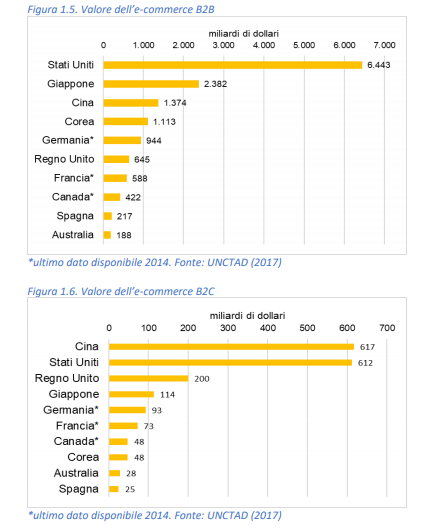
E-commerce in Italy
In line with global e-commerce trends, online sales are an increasingly important phenomenon in our country as well, with a progressively wider scope of action.
In 2017, the value of B2C e-commerce demand in Italy exceeded 23.6 billion euros, thanks to an increase of 17% compared to 2016. 22 million Italians have made at least one purchase via the internet in the last year, 10% more than the 20 million people in 2016.
Going into detail, there are 16.2 million regular buyers. This category of consumers spends an average of €1,357 per year, generating 93% of Italian eCommerce demand.
2017 was also the year in which Italian e-commerce of products surpassed that of services for the first time. In fact, 52% of turnover (€12.2 billion) is generated by the sale of products, which recorded a growth of 28% compared to 2016. The main products purchased are clothing, furniture, beauty products, publishing, toys, food, IT and consumer electronics, merchandising and auto parts.
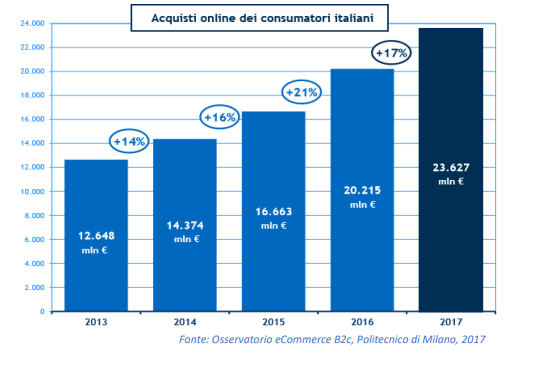
In 2017, there is still an imbalance in the use of the web to make purchases between regions and between types of contexts (metropolitan, urban or suburban areas). In the North, on average, 57% of the population shops online compared to 42% in the South and 49% on the islands.
Moving on to examine the characteristics of the offer, however, the percentage of companies that sell through e-commerce continues to increase, albeit slowly. According to Istat, in 2017 12.5% of Italian companies sold online, compared to 11% in 2016 and 10% in 2015. However, the territorial distribution is once again unbalanced. About 14.7% of companies in Northern Italy made online sales, compared to 9.8% in Central and Southern Italy.
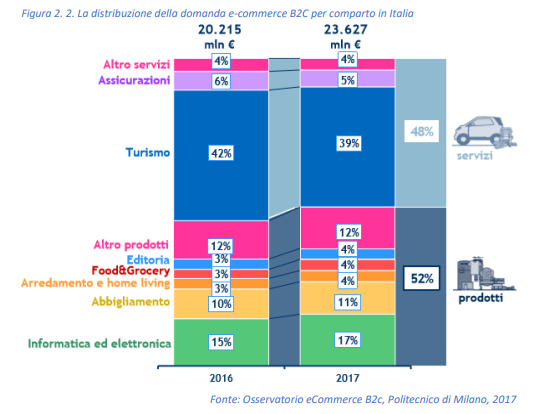
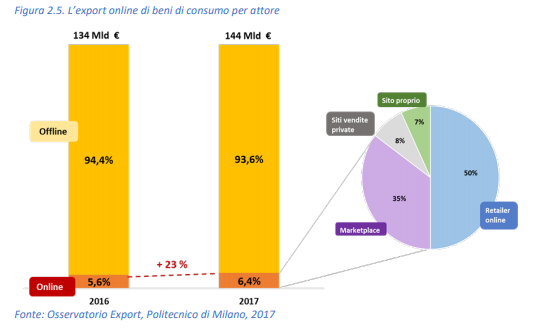
The market in China
In 2017, China was confirmed as the world’s leading B2C e-commerce market, with a value of €752 billion, or about 32% of the world’s B2C e-commerce.
One of the key features of China’s B2C e-commerce market is the high degree of concentration, as the top two players hold 84% of the market and the top four
exceed 90%. The first site is Tmall, Alibaba’s B2C platform, which has a 57% market share. In second place is the online retailer JD.com, with 27%, then
Suning with 5%, and VIP with 3%. All the other initiatives, including Western ones, including Amazon, have a very limited weight, less than one percentage point.
Unlike Western markets, where desktop commerce plays a predominant role, mobile purchases accounted for 73% of B2C e-commerce transactions in China in 2017.
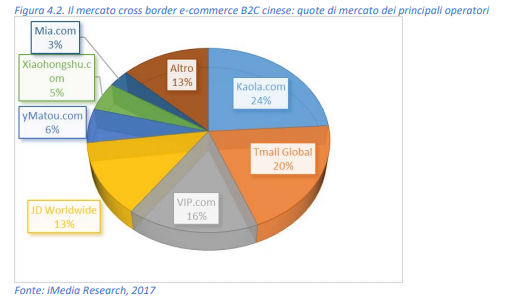
The market in the USA
The United States is the third largest destination market for Italian exports. The U.S. B2C e-commerce market is now developed, but it continues to grow. In 2017 it reached a value of 546 billion euros, with a growth of almost 12% compared to 2016, in line with that recorded in recent years. The U.S. consolidates its second place in the world in terms of B2C e-commerce market value, behind China.
Brand identifiability and communication play a key role. You need to know how to choose according to the product and the message you want to convey. However, there is a problem of skills within many companies, especially small ones, in dealing with organizational problems related to the development of e-commerce.
Strategies
ICE’s eCommerce strategy is part of a broader export strategy, which has the following main objectives to support Made in Italy:
- Increasing the volume of companies’ exports
exporters and increase the total number of
Same. - Seizing opportunities related to demand growth
and the growth of the middle class in the markets
Emerging. - Expand your presence in countries where the potential is
major. - Increase the ability to intercept foreign investments.
Measure g) “Support for the use of eCommerce tools by small and medium-sized enterprises”, introduced by the Extraordinary Plan, is aimed at strengthening the tools available to SMEs for digitisation to facilitate access to digital platforms and
promote e-commerce as a new channel of commercial penetration, to enable SMEs to overcome their size and location limitations, thanks to immediate access to global markets.
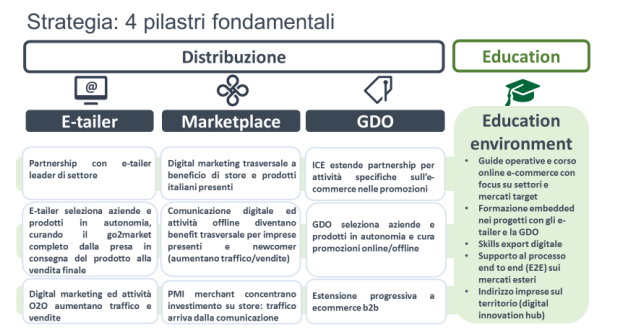
Agreements with international e-tailers, investments in digital marketing and O2O (offline to online) activities and partnerships with international and foreign market-places of primary importance to generate traffic for Italian companies. In addition, the use of cross-border mode, which allows the sale of products that are not registered in China and do not have the Chinese label, has reduced the barriers to purchase for the Chinese audience. Of fundamental importance are the agreements with Yoox, Alibaba and Amazon, which will significantly increase the visibility potential for Italian brands.
Final Thoughts
The numbers, trends and expectations give a very positive picture, the opportunity for Italian brands is tangible and can no longer be ignored, eCommerce is an indispensable tool from an export perspective.
But don’t let yourself be carried away by enthusiasm alone, because entering new markets brings with it some risks that must be managed preventively and strategically.
Both the aspects related to Cyber security, and the “protection” of the brand that is difficult to control on market-places, are aspects to be immediately taken into account when deciding to expand into foreign markets. From this point of view, a consortium vision on the part of Italian companies could be a medium-long term strategy capable of guaranteeing reliability and constant growth, limiting as much as possible the externalities related to safety and market-places.
New opportunities also mean new threats!
Useful sources and links:
Hello ITA Alibaba:
https://www.ice.it/it/node/5392
XXX General Assembly Italy-Japan Business Group:
https://www.ice.it/it/area-clienti/eventi/dettaglio-evento/2017/B1/038
Useful info ITA-ICE:
https://www.ice.it/it/settori/commercio-distribuzione-e-commerce
ICE website:
https://www.ice.it/it/it
Export-South Plan:
https://www.ice.it/it/piano-export-il-sud
eCommerce Export Report:
https://www.ice.it/it/sites/default/files/inline-files/E-commerce_021018_WEB_DEF.pdf
